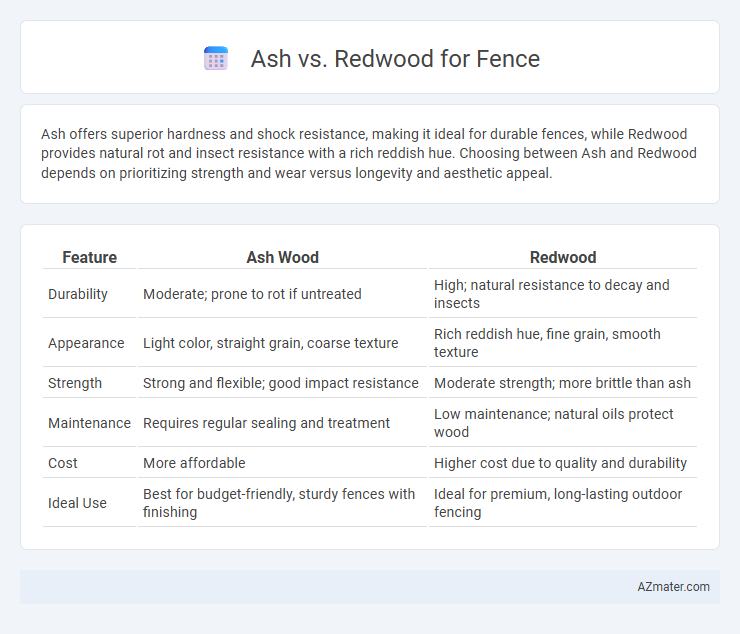Ash offers superior hardness and shock resistance, making it ideal for durable fences, while Redwood provides natural rot and insect resistance with a rich reddish hue. Choosing between Ash and Redwood depends on prioritizing strength and wear versus longevity and aesthetic appeal.
Table of Comparison
| Feature | Ash Wood | Redwood |
|---|---|---|
| Durability | Moderate; prone to rot if untreated | High; natural resistance to decay and insects |
| Appearance | Light color, straight grain, coarse texture | Rich reddish hue, fine grain, smooth texture |
| Strength | Strong and flexible; good impact resistance | Moderate strength; more brittle than ash |
| Maintenance | Requires regular sealing and treatment | Low maintenance; natural oils protect wood |
| Cost | More affordable | Higher cost due to quality and durability |
| Ideal Use | Best for budget-friendly, sturdy fences with finishing | Ideal for premium, long-lasting outdoor fencing |
Introduction to Ash and Redwood Fencing
Ash and Redwood are popular choices for fencing due to their unique properties and aesthetic appeal. Ash offers a light, sturdy wood with a smooth grain, providing durability and a natural look ideal for both traditional and contemporary fences. Redwood is prized for its rich color, resistance to decay, and insect repellant characteristics, making it a long-lasting option that requires minimal maintenance.
Durability Comparison: Ash vs Redwood
Ash wood offers exceptional hardness and impact resistance, making it highly durable for fence construction in areas prone to physical stress. Redwood naturally contains tannins and oils that resist decay, insects, and moisture, providing long-lasting performance in outdoor environments. While Ash is strong and shock-resistant, Redwood's inherent rot resistance and minimal maintenance needs generally result in greater overall durability for fencing applications.
Aesthetic Appeal: Grain, Color, and Texture
Ash wood offers a light, creamy color with a straight, pronounced grain that provides a clean and classic aesthetic for fences. Redwood features rich, reddish hues with a natural luster and a fine, even texture that enhances outdoor spaces with warm, rustic charm. Both woods offer unique visual appeal, but Ash's smooth texture contrasts with Redwood's more vibrant color variations and softer grain pattern.
Cost Analysis of Ash and Redwood Fences
Ash fences typically cost less per linear foot compared to redwood, making them a more budget-friendly option for homeowners. Redwood fences have a higher upfront price due to their natural resistance to decay and insects, which can reduce long-term maintenance expenses. When evaluating cost effectiveness, it's essential to consider both the initial installation price and the lifespan differences between ash and redwood materials.
Maintenance Requirements for Each Wood Type
Ash fences require regular sealing or staining every 2-3 years to protect against moisture and prevent warping, while Redwood naturally resists rot and insect damage, reducing the need for frequent treatments. Ash is more susceptible to cracking and splitting if not properly maintained, leading to higher upkeep costs over time. Redwood's natural oils help maintain its durability with minimal maintenance, making it a preferred choice for low-maintenance fencing solutions.
Resistance to Rot, Pests, and Weather
Ash wood is moderately resistant to rot and pests but tends to absorb moisture, which can lead to faster deterioration in wet climates. Redwood offers superior natural resistance to rot, insects, and harsh weather conditions due to its high tannin content and dense grain structure, making it ideal for outdoor fence applications. Choosing redwood for fencing ensures longer-lasting durability and reduced maintenance compared to ash, especially in environments prone to moisture and insect activity.
Environmental Impact and Sustainability
Ash wood, known for its rapid growth rate and natural strength, offers a more sustainable option for fencing compared to Redwood, which grows slower and is often harvested from old-growth forests. Ash's renewability and lower environmental footprint result from responsible sourcing practices and reduced transportation emissions when sourced locally. Redwood, while naturally resistant to decay, has a higher carbon impact due to longer growth cycles and less replenishable supply, making Ash a more eco-friendly choice for sustainable fencing projects.
Installation Process and Workability
Ash offers straightforward installation due to its uniform grain and moderate hardness, allowing for easy cutting and fastening with standard tools. Redwood's natural resistance to decay and insects reduces the need for extensive preparation or treatment during installation, but its softer texture requires careful handling to avoid dents and splits. Both woods provide excellent workability, though ash demands more precise handling to prevent splintering, while redwood's lighter weight simplifies transport and installation on-site.
Longevity and Life Expectancy
Ash wood typically offers a moderate lifespan of around 10 to 15 years when used for fencing, owing to its decent resistance to wear but limited natural rot resistance. Redwood, known for its exceptional durability, can last 20 to 30 years or more due to its natural oils that protect against decay, insects, and weathering. Choosing redwood for fencing ensures greater longevity and less frequent maintenance compared to ash, making it a superior option for long-term outdoor use.
Best Applications: Choosing Ash or Redwood for Your Fence
Ash wood offers exceptional strength and shock resistance, making it ideal for fences requiring high durability and impact tolerance in harsh weather conditions. Redwood's natural resistance to decay and insects suits outdoor fencing that demands longevity and minimal maintenance, especially in wet or humid climates. Choosing between Ash and Redwood depends on your climate, desired fence appearance, and maintenance preferences for optimal performance and aesthetic appeal.

Infographic: Ash vs Redwood for Fence
 azmater.com
azmater.com